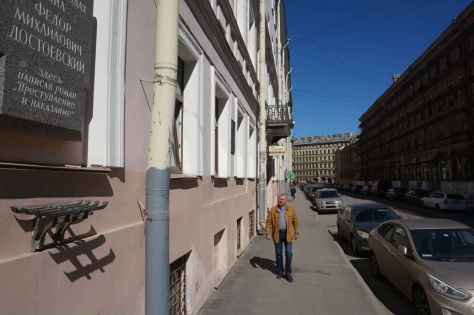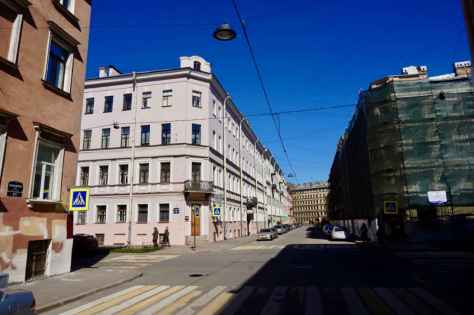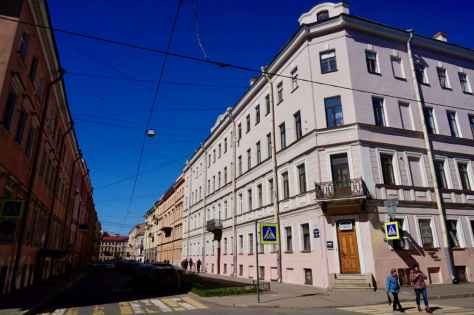

I’m coming to you with Dostoevsky today because I have been inside of Dostoevsky’s head all morning and afternoon. I began my day at my computer early this morning as my wife slept and I translated (portions of) Dostoevsky’s The Idiot into English on an empty stomach. It was one of the most memorable few hours of my life not only as a translator, but of my life, plain and simple. By the time Oksana came out and we shared our breakfast of oatmeal, I felt as though someone had plugged me into an electrical outlet. I think my eyes were giving off light. I think my skin was twitching. I could feel the air move through the hairs on my arms. I was as alive as one gets on a Sunday morning before breakfast. When she got up, Oksana asked me the usual question, “Did you have your glass of water?” I said, “No. I’m translating Dostoevsky. I’ve never felt so alive.”
Dostoevsky has followed me my entire adult life. He came quickly after Tolstoy when I was in high school. It was War and Peace then Anna Karenina then Crime and Punishment. I don’t remember the order anymore, but the next three reads were: The Brothers Karamazov, The Demons (The Possessed), and The Idiot, whatever the order was.
As I said, I was with The Idiot this morning. One of the segments I was translating (for supertitles for a theatre production of The Idiot) was the famous description of a condemned man waking in the morning, thinking he has a week to live – a whole, long week – and he finds out he has hours left to live – whole, long hours. It’s one of the great passages in world literature and I was privileged to have it pass through me today and emerge in English of some kind.
Dostoevsky is surely the most crooked, whacked-out, unorthodox, clumsy, prolix, confusing writer that ever put pen to paper. And therein, of course, lies his greatness. He is one of the chosen few who trusted his own instincts to the very end and went with them. Nobody ever wrote like Dostoevsky, clunking, tripping, stumbling, slogging along with interjections, bare naked adverbs, truncated thoughts, U-turns in logic, ellipses run amok, feverish exclamations, sentences jammed into one another that seem never to end, falling over commas, semi-colons, colons, dashes and whatever other signs he could conjure up and throw in between his words. And every trip and every stumble and every whip-around back in the opposite direction drives deeply into your heart, your soul and the soft matter of your brain. That man, that writer, was plugged into the truth. The truth is messy and complex and Dostoevsky, writing the truth, wrote messily and complexly. He is hell on steroids for a translator, and I’ve never enjoyed hell as I have done translating large excerpts from The Idiot these last weeks. Today was an epiphany, it was fireworks, it was the piece de resistance, the cornerstone of the work I’ve been doing. It was as if I climbed Olympus and Homer was there to greet me. Only Homer had Dostoevsky’s beard. It was joy, sheer, unadulterated joy.





In honor of this splendid day I have spent, I am showing you ground zero in St. Petersburg: the building in which Dostoevsky lived when he wrote Crime and Punishment. Surely when you think “Dostoevsky,” you think Crime and Punishment. As I say, it was the first Dostoevsky novel I read, and it was my third Russian novel in a youthful, drunken literary spree that – thank you, Lord – took me in different directions from Brett Kavanaugh. But my connections to Crime and Punishment are deeper than that, for I have lived the last quarter century with one of the seemingly peripheral characters of Dostoevsky’s great novel of suffering, discovery and redemption. By that I mean to say that Oksana Mysina, my wife, has, for 25 years, played Katerina Ivanovna, the wife of the drunkard Marmeladov, in Kama Ginkas’s great (the word is used properly here) production called K.I. from ‘Crime’, which, in its two and a half decades, has performed in some 20 countries even as it continues to run in Moscow. I could write a book about what it’s like to live with a character shaped not only by a genius writer, but by a genius theater director, but I won’t say a single other word about that now. That’s a whole other can of worms.
The building pictured here (now a light pink – I don’t know what it was like 150 years ago) stands at the corner of Stolyarny Lane 14 and Kaznacheiskaya Street 7. (Kaznacheiskaya was called Malaya Meshchanskaya Street when Dostoevsky lived there.) The plaque hanging on the wall on the Kaznacheiskaya side declares: “Fyodor Mikhailovich Dostoevsky lived in this house from 1864 to 1867. Here was written the novel Crime and Punishment.” But that only tells one quarter of the story of this street crossing. Dostoevsky lived or spent time in all four of the buildings that stand on this corner! Two have plaques, one has information put up by a cafe proprietor, and the other was under reconstruction when I photographed it this summer. I couldn’t tell if anything was written there. But the point is, when you stand in the middle of this intersection, Dostoevskian winds blow at you from all sides – rather like they do in his novels.
When Dostoevsky lived here the building belonged to Ivan Alonkin, a merchant, tea-seller, and apartment-house owner. Dostoevsky occupied Apt. 36 on the second floor. In addition to Crime and Punishment, Dostoevsky wrote the novellas Notes from Underground and The Gambler while living here. The building was originally erected in 1822 and was rebuilt/restructured several times since.
This is the place where Dostoevsky declared his love for his stenographer Anna, who subsequently became his wife and, quite probably, saved his life. Thanks to Anna’s memoirs, we even know a little about Alonkin and the apartment. According to an online Dostoevsky encyclopedia, Anna recalled Alonkin describing Dostoevsky as a “great worker. When I go to morning prayers and I see the light on in his study, it means he is working.” Anna went on about Alonkin: “He never bothered reminding us about the rent, knowing that when money would come in, Fyodor Mikhailovich would pay him. Fyodor Mikhailovich loved talking to the venerable old man. In my opinion, Fyodor Mikhailovich relied on his [Alonkin’s] physical appearance to shape the merchant Samsonov, Grushenka’s patron, in The Brothers Karamazov.”
The rent for Apt. 36, Malaya Meshchanskaya was 25 rubles a month. Dostoevsky paid two months in advance (without signing a rental contract), plus a 10 ruble deposit the day before he officially rented the space.






I second those thoughts, and it’s a very timely post for me, because I’m in the midst of a Dostoevsky obsession myself — I’ve been reading Frank’s biography for years now, reading the works (in Russian) as I go; I’m now several chapters into The Devils, and it may well be that I’ll get to the Holy Grail as soon as next year: The Brothers Karamazov. That was the first of his novels I read, far too early; I didn’t understand much of it, but it overpowered me and shook me and dropped me in a much-altered heap, and I’ve been looking forward to rereading it for decades. I agree with you about the impact of his prose, and I feel sorry for those benighted souls (like Nabokov) who don’t understand his greatness.
I snip at Nabokov from time to time; surely I will find reason to do so again in the future… ))) I myself never liked Nabokov – I found him mannered and fake, probably because I have such an affinity for Dostoevsky’s “real” (???) speech. If it were just that (just his dislike of Dostoevsky’s “chaos”), that would be one thing. But then there’s that abominable translation of Onegin to consider… Don’t get me started! ))) Good to hear from you again!
What a wonderful piece! And I enjoyed the photos too!
Thank you, Elisabeth! Good to have you hang with me even though time restraints have made my posts few and far between of late…
I’m always interested in your posts!